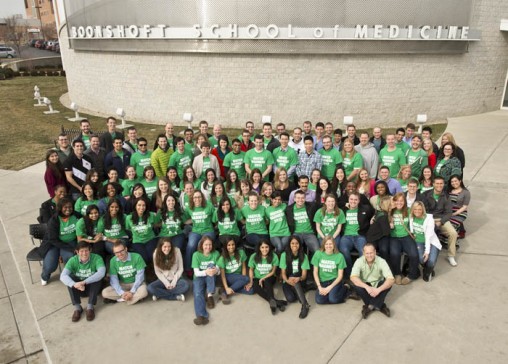
One hundred and one graduating medical students in the Wright State University Boonshoft School of Medicine learned March 15 which residency programs they will enter after receiving their medical degrees in May.
A long-standing tradition at medical schools nationwide, Match Day is a highly anticipated event. It is the day that medical students learn where they are heading as new doctors to receive advanced clinical training in a residency program.
Gathered with family, friends and other supporters in the Berry Room of the Wright State University Nutter Center, the students took part in the national event that has become a rite of passage for those on the brink of becoming physicians.
Each year, the National Resident Matching Program (NRMP) analyzes the preferences of almost 16,000 U.S. medical school seniors, 15,000 other applicants and 4,200 residency programs with 24,000 open positions. Based on this analysis, the NRMP determines who will fill each position. The results are released nationwide at the same time.
Depending on where they match, students will spend the next three to five years as residents receiving advanced training in a primary care field or one of dozens of medical specialties. Wright State students matched in outstanding programs in Dayton, throughout Ohio, and across the country, including Case Western Reserve, the Cleveland Clinic, Duke University and the Mayo Clinic.
More than one-third (37 percent) of the Wright State graduates will remain in Ohio during residency, and 13 percent will remain in the Dayton area. More than half (50.5 percent) will enter a primary care field (Family Medicine: 10.9 percent; Internal Medicine: 23.8 percent; Pediatrics: 13.9 percent; Emergency Medicine/Family Medicine: 1 percent; and Psychiatry/Family Medicine: 1 percent). The rest matched in 12 other specialties: Anesthesiology: 8.9 percent: Dermatology: 1 percent; Emergency Medicine: 8.9 percent: Obstetrics and Gynecology: 4 percent; Ophthalmology: 2 percent; Orthopaedic Surgery: 4 percent; Otolaryngology: 1 percent; Pathology-Anatomic and Clinical: 1 percent; Physical Medicine and Rehabilitation: 1 percent; Psychiatry: 5 percent; Radiology-Diagnostic: 1 percent; and Surgery-General: 10.9 percent.
For more information, contact Cindy Young at cindy.young@wright.edu or visit http://www.med.wright.edu

 Wright State alum Lindsay Aitchison fulfills childhood space-agency dream
Wright State alum Lindsay Aitchison fulfills childhood space-agency dream  Wright State business professor, alumnus honored by regional technology organizations
Wright State business professor, alumnus honored by regional technology organizations  Wright State University Foundation awards 11 Students First Fund projects
Wright State University Foundation awards 11 Students First Fund projects  Gov. DeWine reappoints Board Treasurer Beth Ferris and names student Ella Vaught to Wright State Board of Trustees
Gov. DeWine reappoints Board Treasurer Beth Ferris and names student Ella Vaught to Wright State Board of Trustees  Joe Gruenberg’s 40-Year support for Wright State celebrated with Honorary Alumnus Award
Joe Gruenberg’s 40-Year support for Wright State celebrated with Honorary Alumnus Award 